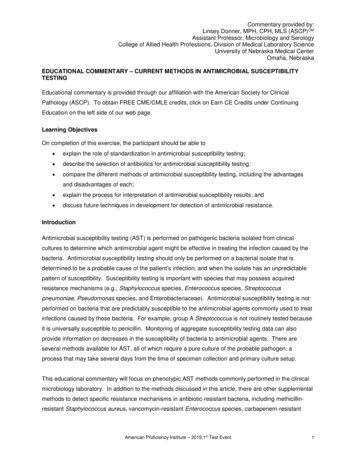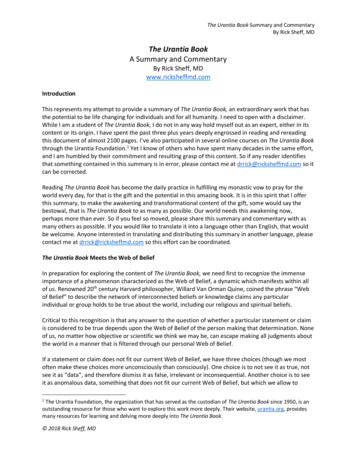
Transcription
Commentary provided by:Linsey Donner, MPH, CPH, MLS (ASCP)CMAssistant Professor, Microbiology and SerologyCollege of Allied Health Professions, Division of Medical Laboratory ScienceUniversity of Nebraska Medical CenterOmaha, NebraskaEDUCATIONAL COMMENTARY – CURRENT METHODS IN ANTIMICROBIAL SUSCEPTIBILITYTESTINGEducational commentary is provided through our affiliation with the American Society for ClinicalPathology (ASCP). To obtain FREE CME/CMLE credits, click on Earn CE Credits under ContinuingEducation on the left side of our web page.Learning ObjectivesOn completion of this exercise, the participant should be able to explain the role of standardization in antimicrobial susceptibility testing; describe the selection of antibiotics for antimicrobial susceptibility testing; compare the different methods of antimicrobial susceptibility testing, including the advantagesand disadvantages of each; explain the process for interpretation of antimicrobial susceptibility results; and discuss future techniques in development for detection of antimicrobial resistance.IntroductionAntimicrobial susceptibility testing (AST) is performed on pathogenic bacteria isolated from clinicalcultures to determine which antimicrobial agent might be effective in treating the infection caused by thebacteria. Antimicrobial susceptibility testing should only be performed on a bacterial isolate that isdetermined to be a probable cause of the patient’s infection, and when the isolate has an unpredictablepattern of susceptibility. Susceptibility testing is important with species that may possess acquiredresistance mechanisms (e.g., Staphylococcus species, Enterococcus species, Streptococcuspneumoniae, Pseudomonas species, and Enterobacteriaceae). Antimicrobial susceptibility testing is notperformed on bacteria that are predictably susceptible to the antimicrobial agents commonly used to treatinfections caused by those bacteria. For example, group A Streptococcus is not routinely tested becauseit is universally susceptible to penicillin. Monitoring of aggregate susceptibility testing data can alsoprovide information on decreases in the susceptibility of bacteria to antimicrobial agents. There areseveral methods available for AST, all of which require a pure culture of the probable pathogen: aprocess that may take several days from the time of specimen collection and primary culture setup.This educational commentary will focus on phenotypic AST methods commonly performed in the clinicalmicrobiology laboratory. In addition to the methods discussed in this article, there are other supplementalmethods to detect specific resistance mechanisms in antibiotic-resistant bacteria, including methicillinresistant Staphylococcus aureus, vancomycin-resistant Enterococcus species, carbapenem-resistantAmerican Proficiency Institute – 2019 1st Test Event1
EDUCATIONAL COMMENTARY – CURRENT METHODS IN ANTIMICROBIAL SUSCEPTIBILITYTESTING (cont.)Enterobacteriaceae, extended-spectrum β-lactamase–producing gram-negative rods, organisms thatinduce clindamycin resistance, and β-lactamase–producing Haemophilus species. These supplementalmethods, in addition to a number of new emerging technologies, are important for the clinicalmicrobiologist in the detection of drug-resistant bacteria.Standardization of Antimicrobial Susceptibility TestingTo ensure that their test results are reliable, clinical microbiology laboratories should adhere to thestandards that have been developed by the Clinical and Laboratory Standards Institute (CLSI) whenperforming AST. Environmental and technical factors have an enormous impact on susceptibility testresults. Factors such as bacterial inoculum size, growth medium, incubation conditions, and antibioticconcentrations must be standardized to minimize the impact of these variables. The goals ofstandardization in AST are as follows:1. Optimize the growth conditions so test results cannot be attributed to limitations of nutrients,temperature, or atmosphere2. Optimize antimicrobial integrity and activity so that resistance cannot be attributed toenvironmental drug deactivation3. Maintain interlaboratory reproducibility and consistency of results.1,2The CLSI standards provide information necessary to perform an AST, from media selection to qualitycontrol. Two documents that describe the standardized components of disk diffusion and dilutionsusceptibility testing methods are CLSI document M02, Performance Standards for Antimicrobial DiskSusceptibility Tests, and document M07, Methods for Dilution Antimicrobial Susceptibility Tests forBacteria That Grow Aerobically.3 They are to be used in conjunction with M100, Performance Standardsfor Antimicrobial Susceptibility Testing,4 which provides supplemental tables to be used with disk diffusionand minimum inhibitory concentration (MIC) tests. The MIC is the lowest concentration of an antibioticthat inhibits the visible growth of an organism. The M100 document is updated annually, and the otherCLSI standards are revised frequently, so laboratories should review their procedures annually to ensurethey incorporate the most current standards. These CLSI standards, resources, and other documentscan be found and purchased at http://www.clsi.org.Selection of Antibiotics for TestingAntibiotics selected for susceptibility testing should provide information so that the physician canappropriately treat the patient’s infection. Antibiotics that are not effective against a particular pathogenicorganism or within a particular body site should not be tested or reported. Those tested and reportedAmerican Proficiency Institute – 2019 1st Test Event2
EDUCATIONAL COMMENTARY – CURRENT METHODS IN ANTIMICROBIAL SUSCEPTIBILITYTESTING (cont.)should be relevant to the patient’s infection and clinical condition, appropriate for the organism isolated,and follow the health care institution’s formulary, which is the group of antibiotics available for prescribingby the clinicians. The CLSI M100 document provides tables that list the antimicrobial agents appropriatefor testing Enterobacteriaceae, Pseudomonas, other gram-negative glucose nonfermenters, enterococci,streptococci, staphylococci, Neisseria meningitidis, and Haemophilus species.4 The lists includerecommendations for antibiotics that should be tested routinely and those that may be tested or reportedselectively.Each laboratory must consider the availability of antibiotics for testing by the laboratory’s routine testingmethodology and compare that with the health care institution’s formulary. The disk diffusion andgradient diffusion methods offer the greatest flexibility in antibiotic selection, including for testing of newlyavailable antimicrobial agents.Methods of Antimicrobial Susceptibility TestingTo perform AST, most clinical laboratories use either disk diffusion or a broth microdilution method. Inaddition, many laboratories use gradient diffusion strips to perform AST on certain drug-organismcombinations. All methods have been researched, and when performed correctly with the standardsfollowed, all methods are reliable.Broth MicrodilutionDilution susceptibility testing is used to quantitate the in vitro activity of an antimicrobial agent against anorganism. Varying concentrations of the antimicrobial agent are tested with the organism in serial twofold dilutions. Historically, AST dilution tests were performed using a macrobroth dilution, or tube dilution,method. Owing to the tedious preparation, large amount of space and reagents required, and possibilityof errors in preparation, this method has been replaced by the automated microdilution method, which isa miniaturization of the macrodilution.The microdilution method (Figure 1) has been standardized by use of small disposable plasticmicrodilution trays, cassettes, or cards that contain miniature wells. Each well contains a specificconcentration of lyophilized or frozen antibiotic and a volume of 0.1 to 0.5 mL, which allows approximately12 antibiotics to be tested in a range of 8 two-fold dilutions in a single test.1,2,3,5 The panels are fixed withspecific antibiotics, contain a growth control and purity control, and are purchased from commercialmanufacturers. A standardized suspension is made of pure bacterial growth and diluted so the finalconcentration in each well of the panel is equal to 5 105 colony forming units (CFU) per milliliter.6 SomeAmerican Proficiency Institute – 2019 1st Test Event3
EDUCATIONAL COMMENTARY – CURRENT METHODS IN ANTIMICROBIAL SUSCEPTIBILITYTESTING (cont.)commercial systems contain automatic inoculating devices, or the microwells may be inoculated withmultichannel pipettors. After incubation, MICs are determined using a manual or automated viewingdevice for inspection of each of the panel wells for growth. The MIC is then compared with the CLSIbreakpoints in the M100 document to determine whether the organism is susceptible, susceptible–dosedependent, intermediate, or resistant.2,4Figure 1. A broth microdilution susceptibility panel containing miniature wells.There are currently four commercial automated or semiautomated instruments cleared by the US Foodand Drug Administration (FDA) available in the United States. They are the MicroScan WalkAway ,bioMérieux Vitek-2 , BD Phoenix automated system, and Thermo Scientific SensititreTM.5,7 Use of anautomated instrument broth microdilution assay provides precise, reliable, and quantitative test results ina shorter period than manual readings because the sensitive optical detection system allows detection ofsubtle changes in bacterial growth.5The advantages of the microdilution susceptibility test include the quantitative MIC result, streamlinedworkflow, convenience and reproducibility of commercially prepared panels, ability to interface with thelaboratory information system to transfer results, and generation of computerized reports if an automatedAmerican Proficiency Institute – 2019 1st Test Event4
EDUCATIONAL COMMENTARY – CURRENT METHODS IN ANTIMICROBIAL SUSCEPTIBILITYTESTING (cont.)panel reader is used.1,5 Disadvantages include the inflexibility of antibiotic selection due to thecommercially purchased panels, delays between the update of clinical breakpoints and clearance oncommercial systems, strict regulations by the FDA concerning which antibiotic-organism combinationscan be tested by commercial systems, lengthy time period between new antibiotic approval and additionto the commercial panels, and lack of performance review of commercial systems as new antimicrobialresistance emerges.7Disk DiffusionDisk diffusion susceptibility testing, or the Kirby-Bauer disk diffusion test, is performed by inoculating astandardized suspension of pure bacterial growth equal to 1.5 108/mL CFU, or equivalent to a 0.5McFarland turbidity standard, to the surface of a Mueller-Hinton agar plate, creating a lawn of growth ofthe bacteria.1,2,6 If the organism tested is fastidious and requires an enriched medium to grow, theMueller-Hinton agar may be supplemented with additional growth ingredients such as sheep’s blood (e.g.,Streptococcus pneumoniae) or hemin and nicotinamide adenine dinucleotide (NAD) (e.g., Haemophilusspecies). Commercially prepared paper disks with specific concentrations of antibiotics are then placedon the inoculated agar surface. The plates are incubated in ambient air or CO2 at 35 C for 16 to 24 hoursdepending on the suspected organism and antibiotic. After incubation, the plates are examined forgrowth inhibition which creates a zone around the antibiotic disk (Figure 2). The diameter of the zone ofinhibition is measured to the nearest millimeter. The zone diameter is an indicator of the relativesusceptibility of the organism to the antibiotic. Disk diffusion AST is a qualitative susceptibility test, that is,results are reported only as susceptible, intermediate, or resistant rather than including a quantitativeMIC.1,2,6There are several advantages of the disk diffusion AST, including that it is technically easy, does notrequire special equipment, is inexpensive, provides flexible antibiotic choices, and results are easilyinterpreted. The disadvantages of the disk diffusion test are the lack of automation, making it timeconsuming to perform and interpret, and the lack of quantitative MIC results, which are necessary fortreatment in some infections.1,2,5,6American Proficiency Institute – 2019 1st Test Event5
EDUCATIONAL COMMENTARY – CURRENT METHODS IN ANTIMICROBIAL SUSCEPTIBILITYTESTING (cont.)Figure 2. A disk diffusion test with an isolate of Pseudomonas aeruginosa from aculture. The diameters of all zones of inhibition for each antibiotic are measuredand those values translated to breakpoint categories of susceptible, susceptibledose dependent, intermediate, or resistant using the latest tables published by theClinical and Laboratory Standards Institute.Gradient DiffusionGradient diffusion tests are a variation of the disk diffusion test which provides a quantitative MIC value.The bioMérieux ETEST is a commonly used gradient diffusion AST available in the United States. Thissusceptibility test consists of a predefined gradient of antibiotic concentrations on one side of a thinplastic strip, with an interpretation scale printed on the other (top) side of the strip. The agar plate isinoculated the same as in disk diffusion, and the gradient strips are placed on the agar surface with theantibiotic side on the agar. After 24-hour incubation, an inhibition ellipse is visible (Figure 3). Thequantitative MIC corresponds to the point on the strip where the antimicrobial concentration is no longerinhibiting bacterial growth, or where the elliptical zone of inhibition intersects the strip. 1,2,5,6American Proficiency Institute – 2019 1st Test Event6
EDUCATIONAL COMMENTARY – CURRENT METHODS IN ANTIMICROBIAL SUSCEPTIBILITYTESTING (cont.)Gradient diffusion susceptibility tests are flexible in their ability to test specific antibiotics chosen by thelaboratory. However, the strips are expensive, especially if more than a few drugs are tested. Thismethod is best applicable to situations where only one or two antibiotics are needed, or when a fastidiousorganism requiring an enriched medium or special incubation atmosphere is to be tested.Figure 3. A Streptococcus pneumoniae isolate tested by gradient diffusion methodon Mueller-Hinton agar supplemented with sheep’s blood. The minimum inhibitoryellipse concentration of each antibiotic is determined by the intersection of theorganism growth with the strip as measured using the scale printed on the strip.Interpretation of Antimicrobial Susceptibility Test ResultsThe zone diameters or MIC of each antibiotic are interpreted using the breakpoints published by CLSI orthose included in the inserts of FDA-approved products. A breakpoint is defined as the concentration ofAmerican Proficiency Institute – 2019 1st Test Event7
EDUCATIONAL COMMENTARY – CURRENT METHODS IN ANTIMICROBIAL SUSCEPTIBILITYTESTING (cont.)an antibiotic that enables interpretation of AST to define isolates as susceptible, susceptible–dosedependent, intermediate, or resistant.2,4,7Laboratories can use either FDA or CLSI breakpoints if performing AST by noncommercial methods suchas disk diffusion or gradient diffusion. If using an automated commercial system, US law requires that thedevices use FDA breakpoints. Owing to the challenge of commercial system manufacturers’ lag inupdating the breakpoints on a yearly basis, laboratories may make CLSI updates to the breakpoints oncommercial systems by performing in-house verification studies to ensure analytic performance of themodification before reporting patient results.7The results of a susceptibility test are compared with the table of values in the CLSI M100 document thatrelate to proven clinical efficacy of each antibiotic for various bacterial species.2,6 Susceptible indicatesthat the antibiotic used in the recommended dosage to treat the site of infection is clinically effective forthat patient’s isolate. Intermediate indicates clinical efficacy in body sites where the antimicrobial agent isphysiologically concentrated or when a higher than normal dosage of antimicrobial agent can be used.Resistant indicates that the isolate is not inhibited by the usually achievable concentrations, likely owingto resistance mechanisms, and clinical efficacy has not been shown in treatment studies. Susceptible–dose dependent indicates that the susceptibility of the patient’s isolate depends on the dose and regimenof the antimicrobial agent and an altered administration regimen - usually higher dosage, more frequentadministration, or both - is needed to reach clinical efficacy.The CLSI zone size and MIC breakpoints are established by analysis of three kinds of data:1. Microbiologic data, including a comparison of MICs and zone sizes on a large number ofbacterial strains, including those with known resistance mechanisms2. Pharmacokinetic and pharmacodynamic data3. Clinical studies results obtained before FDA approval and marketing of an antibiotic.8The results of AST on the patient’s report for the clinician should include the category result ofsusceptible, susceptible–dose dependent, intermediate, or resistant. This information is needed for theclinician to prescribe appropriate targeted antimicrobial therapy. If an MIC is available it can be reportedto aid the clinician in certain infections, such as infective endocarditis or osteomyelitis, because the MICaids in selection of the antibiotic in similar groups. Generally, the reporting category of susceptible,intermediate, susceptible–dose dependent, or resistant will suffice, because the MIC is primarily used byinfectious disease clinicians and pharmacists.2,4,5American Proficiency Institute – 2019 1st Test Event8
EDUCATIONAL COMMENTARY – CURRENT METHODS IN ANTIMICROBIAL SUSCEPTIBILITYTESTING (cont.)Future DirectionsThe ASTs described above are commonly performed phenotypic susceptibility tests that have been usedby clinical microbiology laboratories for many years. In an effort to provide rapid results for the detectionof infectious pathogens and antimicrobial resistance, newer methods have been developed and approvedby the FDA and are being adopted by clinical laboratories. The direct detection of resistance genes bymolecular methods such as polymerase chain reaction (PCR) or similar techniques is widely used for thedetection of specific targets that are associated with phenotypic resistance (e.g., mecA, vanA, vanB andKPC). Depending on the method, these tests can be performed directly on patient specimens or colonialgrowth. Although these molecular methods have had a significant effect in the rapid detection of specificantibiotic resistance, there are hundreds of other mechanisms of resistance, such as β-lactamaseenzyme production, alteration of antibiotic binding sites, and alteration of cell permeability, that result inantibiotic resistance to many different classes of antimicrobial agents. There are too many resistancemechanisms to be easily detected by current molecular techniques. This is why phenotypic AST, whichmeasures the level of susceptibility of bacterial isolates to antimicrobial agents, is still performed today.There is a need for the development of new automated instruments that can provide faster results bydirect specimen testing because the current culture-based AST tools are time-consuming and requireisolation of the pathogen for susceptibility testing, which results in several days’ delay before the MICvalues are determined and reported. Different methodologic approaches for the detection of bacterialgrowth have been explored and are currently being researched by commercial entities for clinicaltranslation. New AST techniques based on optical imaging, microchannel resonators, and otherbiosensors have been pursued.5 There is currently a multiplexed automated digital microscopy imaging–based test available that has been approved by the FDA for blood and urine specimens that utilizes animage of single bacteria growing into colonies with antibiotics and quantifies the growth rate to producean MIC result within 3 to 5 hours.5 The emerging technologies for AST promise results within a fewhours, and some can be directly applied to patient samples without any sample pretreatment.ConclusionAntimicrobial susceptibility testing is used to determine antibiotic resistance profiles of bacterial isolates,to guide antibiotic treatment decisions, and to predict therapeutic outcome. The phenotypic AST methodscurrently used in the clinical microbiology laboratory include disk diffusion, gradient diffusion, andmicrodilution. Disk diffusion AST is easy to perform, low cost, and allows for flexibility in selection ofantibiotics. Gradient diffusion also offers flexibility in selection of antibiotics but is expensive. It is usuallyreserved for situations in which an antibiotic is not yet available for testing on commercial systems, orAmerican Proficiency Institute – 2019 1st Test Event9
EDUCATIONAL COMMENTARY – CURRENT METHODS IN ANTIMICROBIAL SUSCEPTIBILITYTESTING (cont.)there is a fastidious organism that requires an enriched medium or special incubation. Microdilution is themost commonly performed AST method because it can be automated, can be interfaced with thelaboratory information system and generate computerized reports, and many antibiotics can be tested ona single panel. In the future, new innovative technologies will enable an AST within a few hours, whichwill have the potential to enable accurate antibiotic treatment at disease onset, improving antimicrobialstewardship and clinical outcomes.References1.ProcopG et. al. Koneman’s Color Atlas and Textbook of Diagnostic Microbiology, 7th ed.Riverwoods, IL: Wolters Kluwer; 2017.2.Centers for Disease Control and Prevention. CDCTRAIN web-based learning: M.A.S.T.E.RAntimicrobial Susceptibility Testing Methods. https://cdc.train.org/. Accessed November 10, 2018.3.Clinical and Laboratory Standards Institute. Methods for Dilution Antimicrobial Susceptibility Testsfor Bacteria That Grow Aerobically; Approved Standard: 11th Edition. Wayne, PA: Clinical andLaboratory Standards Institute; 2018. CLSI document M07.4.Clinical and Laboratory Standards Institute. Performance Standards for AntimicrobialSusceptibility Testing; Approved Standard: 28th Edition. Wayne, PA: Clinical and LaboratoryStandards Institute; 2018. CLSI document M100S-28.5.Humpries RM and Hindler JA. Emerging resistance, new antimicrobial agents but no tests! thechallenges of antimicrobial susceptibility testing in the current US regulatory landscape. ClinInfect Dis 2016; 63: 83-88. http://doi.org/10.1093/cid/ciw6.Syal K, Mo M, Yu H, et al. Current and emerging techniques for antibiotic susceptibility tests.Theranostics 2017;7(7):1795-1805. http://doi.org/10.7150/thno.192177.Jorgensen JH, Turnidge JD. Antibacterial susceptibility tests: dilution and disk diffusion methods.In: Murray PR, Baron EJ, Jorgensen JH, Landry ML, Pfaller MA, eds. Manual of ClinicalMicrobiology. 9th ed. Washington DC: American Society for Microbiology; 2007:1152-72.8.Clinical and Laboratory Standards Institute. Development of In Vitro Susceptibility Testing Criteriaand Quality Control Parameters; Approved Standard: 5th Edition. Wayne, PA: Clinical andLaboratory Standards Institute; 2018. CLSI document M23. ASCP 2019American Proficiency Institute – 2019 1st Test Event10
Performance Standards for Antimicrobial Disk Susceptibility Tests, and document M07, Methods for Dilution Antimicrobial Susceptibility Tests for Bacteria That Grow Aerobically.3 They are to be used in conjunction with M100, Performance Standards for Antimicrobial Susceptibility Testing,4 wh










